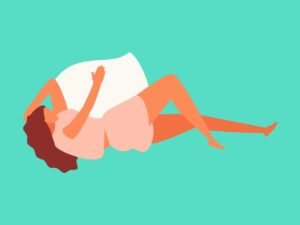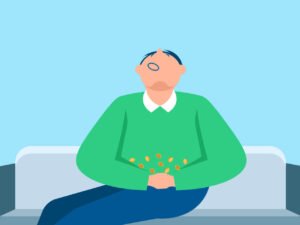Many people nowadays complain about shoulder and neck pain after getting up from bed.
This pain is mostly located in the trapezius area.

Finding the best sleeping position for trapezius pain can help you reduce the severity of the pain.
Contents
What Should You Know About Trapezius Pain?
The trapezius muscle is a large muscle band at the back of the neck.
It extends to the neck, shoulder, and upper back region.
The muscle starts from the cervical region and goes down to the thoracic spinal cord.[1]
It can get stiff and hurt due to pain and stress in neighboring muscles and joints.
If you’re experiencing trapezius pain, you might also experience neck pain, shoulder pain, upper arm pain, and back pain as well.
Pain in the trapezius muscle can be very uncomfortable and sharp, inhibiting everyday movement and activities.
That’s why making sure the pain is healed is important if you want to remain physically active and healthy.
Causes of Trapezius Pain
Here are some of the major reasons you might feel a sharp pain or discomfort in the trapezius:
- Physical Trauma – Physical trauma is the most common reason for trapezius pain. If you fall over your neck or you’re hit on your upper back, it is possible that the blunt force might cause severe pain, discomfort, and even long terms problems to your trapezius.
- Intense Neck and Shoulder Pain – If you have intense and sharp pain in your neighboring muscle groups in the shoulder region and the neck, it is possible that the stress might shift to your trapezius muscle since they’re all interconnected through joints.[2]
- Bad Posture – People who have bad posture and are mostly bent with down shoulders also complain of having pain in their upper back and neck region because of the long-term stretching results on the trapezius region.
- Excessive Shoulder Exercise – If you’re a gym-goer or you’re constantly engaging in activities that require intense physical fitness and muscle strength, it is possible that you might cause stress and pressure on your trapezius muscle and hurt it, ultimately causing pain in the muscle.
Sleeping Position Effects on Health
Your sleeping position is an important factor affecting your physical health.
Have you ever noticed that most of the physical stress and pain introduced in your body seems to show in the morning when you wake up?
That’s because your sleeping position is responsible for much of the physical pain and muscle discomfort you’re facing.
Along with that, if you undergo an injury, even the injury shows its worst effects once you wake up from your slumber.
There are a lot of pains and problems that come with bad sleeping positions.
From something as simple as neck pain and shoulder pain to heartburn, high blood pressure, and even mental problems can occur over time if you continue to sleep in a bad sleeping position.
So, making sure that you sleep perfectly is incredibly important if you want to stay healthy.
Once you figure out that in addition to sleeping 7-8 hours a day, how you sleep and your sleeping posture is also important, and act accordingly, you increase your chances of sleeping relaxed and staying mentally and physically healthy.
The Worst Sleeping Position for Trapezius Pain
If you have trapezius muscle pain, it is highly possible that you got it from a particular sleeping position.
There are some sleeping positions that you should avoid, but the most uncomfortable and detrimental in the long run is none other than sleeping on your stomach.
When you sleep on your stomach, you basically put all the stress of your body directly onto your chest region.
And since you cannot sleep with a straight face buried into the pillow, you have to bend your neck to move it to one of your sides, either left or right.
This bend produces stress and pressure on your neck muscles that sometimes go into the shoulders and even the arms.
Ticking all the boxes for trapezius pain, this sleeping position ends up getting you worked up, and the stress in your neck region finally gets to the trapezius muscle, causing discomfort and pain.
For all of you stomach sleepers out there, it will be ideal for you to change your sleeping position even though you might feel like you’re comfortable sleeping on your stomach.
As they say, prevention is better than cure.
So, moving away from sleeping on your belly would be the best course of action for you.
If for some reason you insist on sleeping on your belly, try to implement at least some of the next adjustments:
- Sleep on an ultra slim pillow to reduce to curl in the neck.
- Turn your head from side to side throughout the night, or even better, place your forehead on a flat pillow so you don’t need to turn your head to the side.
- Avoid placing your hands below your head or below the pillow to avoid shoulder pain.
- Place a pillow under your pelvis to prevent an excessive extension in the spine.
Best Sleeping Position for Trapezius Pain
So, what’s the solution to trapezius muscle pain, and what sleep position is the best to avoid it?
In my experience, and according to the suggestion of many medical professionals, sleeping on your side is the best position for a relaxing sleep.
All you need to do is make sure that you have a thick enough pillow to keep the side of your head elevated as much as it does in a standing position so there’s no bend and stress on the neck that might lead to trapezius pain.

If you’re not comfortable sleeping on your side, try taking small steps and you’ll get used to it, especially once you see it healing your muscular pain.
Benefits of Side Sleeping
There are a lot of benefits that come with sleeping on your side.
Let’s take a look at some of the major benefits that you’ll get if you choose to sleep on your side.
Reduces body pain
When you sleep on your side, your neck is elevated to a comfortable position.
Your shoulders aren’t facing any pressure or discomfort either (unless you have a shoulder injury in the side you are sleeping on).
This allows your body to maintain a stable and calm position and rest completely without tension.
As there is no tension in the body and muscles, you sleep well and you can wake up the next morning happy and well-rested.
Keeps Trapezius Muscle Calm
The trapezius muscle is responsible for keeping the shoulder blades and the neck stable.
When it gets injured or pressurized, it can cause severe pain in the joints and the body’s muscles.
If you sleep on your side, you won’t have to go through any muscle discomfort.
If you have trapezius muscle pain, you can lie on your side, and it will be calm and stable.
It is therefore considered the best sleeping position for trapezius pain.
Helps in Digestion
Sleeping in some sleeping positions can cause your stomach to feel restricted and stressful, which can ultimately cause acid reflux.
But if you sleep on your left side, your guts will remain at rest state, and acid reflux will be at bay.
At the same time, the digestion process will also be improved, helping you stay healthy and fit.

It’s important to say that sleeping on your right side has the reverse effect on digestion, as gravity makes it difficult for food to make it to the stomach.
Promotes Good Breathing
If you sleep on your belly, one big problem you might face is the constriction of your chest and diaphragm.
As a result, you may not able to breathe correctly and it can cause severe problems while sleeping.
With the help of side sleeping, you can reduce the risk of breathing problems since the chest region isn’t pressurized and your airways have breathing space which is incredibly vital for a calm and cool good night’s sleep.
When you sleep on your side, prefer the log position or the yearner position over the fetal position, as in the fetal position, your diaphragm might be constricted.

Boosts Mental Health
Besides offering tons of physical benefits, sleeping on your side also promotes brain functioning and mental health.
When you sleep on your side, your body is able to clear interstitial waste from the brain.[3]
This helps your body have a reduced risk of developing insomnia, brain diseases like Alzheimer’s disease, and Parkinson’s disease.
So, sleeping on your side is not only physically effective but also helps you stay fit mentally.
How to Make Your Sleeping Position More Relaxing
Whether you’re sleeping on your side or on your back, it’s possible that you might be facing some kind of problem or pain in your body.
Well, in that case, here are some of the best tips and tricks you can use to make your sleeping position relaxing:
Use a Sleep Mask Kit
Sleeping mask kits are helpful in making sure that your sleep remains undisturbed for 7-8 hours a day ensuring that your body is relaxed and your mind is completely calm.
These kits include a sleeping mask for your eyes so you can avoid any excessive disturbing light, earplugs for noise reduction sleeping, and some sleeping mask kits come with sleepwear as well.
Sleeping mask kits are pretty effective in making your sleep relaxing.
Perform Deep Breathing
Deep breathing is a very effective process that helps your body get calm and relieved with the help of the oxygen in your atmosphere.
Let’s take a look at how you can perform it:
- Lie down on your bed calmly in a decent and comfortable position.
- Take deep breaths and try to calm yourself down. Think about things that help you feel better and try to be in your mentally happy place.
- Oxygen will slowly flow to all of your organs and muscles and relax them, ultimately making your body relaxed and calm, which helps you reach deep sleep sooner.
Use Pillows the Right Way
Pillows can really make a huge difference and transform a normal sleeping session into a full-fledged comfortable and relaxing sleeping session.
Here’s how you can use pillows in different ways to make your sleeping position more relaxing:
- Hug a pillow. It can prevent an internal rotation in the shoulder. Sleeping with an internally rotated shoulder at night can sabotage your posture and make your shoulder more vulnerable to injuries.
- Keep a pillow between your legs. This will reduce the overall pressure on your spinal cord and reduce the pain that you might have.

Conclusion
Many people search for information on the best sleeping position for trapezius pain.
Trapezius muscle pain can be quite difficult to deal with.
That’s why preventing it is the best option you have.
With the help of side sleeping and the tips to make your sleeping position more relaxing, you can accelerate the healing process of some of your muscle pains, joint pains, and swellings.
I hope that you’re going to have an incredible sleeping experience with the help of this guide.



